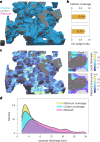Three-dimensional nanoimaging of fuel cell catalyst layers
- PMID: 37252670
- PMCID: PMC10212762
- DOI: 10.1038/s41929-023-00947-y
Three-dimensional nanoimaging of fuel cell catalyst layers
Abstract
Catalyst layers in proton exchange membrane fuel cells consist of platinum-group-metal nanocatalysts supported on carbon aggregates, forming a porous structure through which an ionomer network percolates. The local structural character of these heterogeneous assemblies is directly linked to the mass-transport resistances and subsequent cell performance losses; its three-dimensional visualization is therefore of interest. Herein we implement deep-learning-aided cryogenic transmission electron tomography for image restoration, and we quantitatively investigate the full morphology of various catalyst layers at the local-reaction-site scale. The analysis enables computation of metrics such as the ionomer morphology, coverage and homogeneity, location of platinum on the carbon supports, and platinum accessibility to the ionomer network, with the results directly compared and validated with experimental measurements. We expect that our findings and methodology for evaluating catalyst layer architectures will contribute towards linking the morphology to transport properties and overall fuel cell performance.
Keywords: Electrocatalysis; Energy; Fuel cells; Imaging studies.
© The Author(s) 2023.
Conflict of interest statement
Competing interestsThe authors declare no competing interests.
Figures






References
-
- Fan J, et al. Bridging the gap between highly active oxygen reduction reaction catalysts and effective catalyst layers for proton exchange membrane fuel cells. Nat. Energy. 2021;6:475–486. doi: 10.1038/s41560-021-00824-7. - DOI
-
- Padgett E, et al. Connecting fuel cell catalyst nanostructure and accessibility using quantitative cryo-STEM tomography. J. Electrochem. Soc. 2018;165:F173–F180. doi: 10.1149/2.0541803jes. - DOI
-
- Ko M, Padgett E, Yarlagadda V, Kongkanand A, Muller DA. Revealing the nanostructure of mesoporous fuel cell catalyst supports for durable, high-power performance. J. Electrochem. Soc. 2021;168:024512. doi: 10.1149/1945-7111/abe28e. - DOI
LinkOut - more resources
Full Text Sources
